Track Lighting LED Conversion
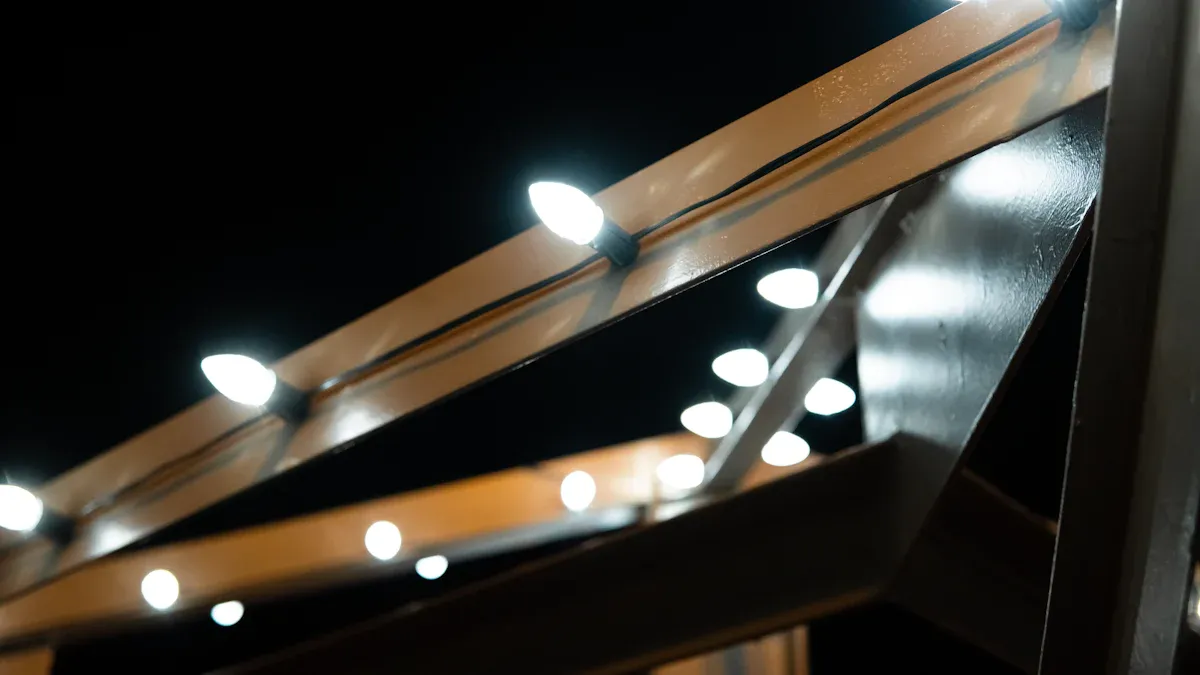
You can start your Track Lighting LED Conversion by simply swapping out your old bulbs for LED ones, but first, check the compatibility and voltage of your system. LEDs use up to 70-80% less energy than traditional bulbs, so you will see real savings on your Home energy bill. Take a look at how long these bulbs last:
Bulb Type | Average Lifespan (hours) |
|---|---|
LED | 10,000 - 50,000 |
Halogen | 1,250 - 2,250 |
Incandescent | 1,000 - 2,000 |
You get brighter, better light and fewer bulb changes. If you want to know more About Us or our Product tips, you will find everything you need right here.
Key Takeaways
Using LED bulbs can help you save a lot of energy. You might save up to 80% on your energy costs. This means your electricity bills will be lower. It also helps the environment by making less pollution.
LED bulbs last much longer than regular bulbs. You will not need to change them as often. LEDs can give you light for up to 50,000 hours.
Pick the right base type and wattage for your LED bulbs. This makes sure they work with your track lighting system. It stops problems with fitting and helps your lights work well.
Always check the voltage of your track system before you install new bulbs. Using the wrong voltage can break your new LED bulbs.
Follow safety steps when you switch to LED lighting. Turn off the power first. Use a voltage tester to check for electricity. Make sure all connections are tight so you stay safe.
Why Switch to LED?
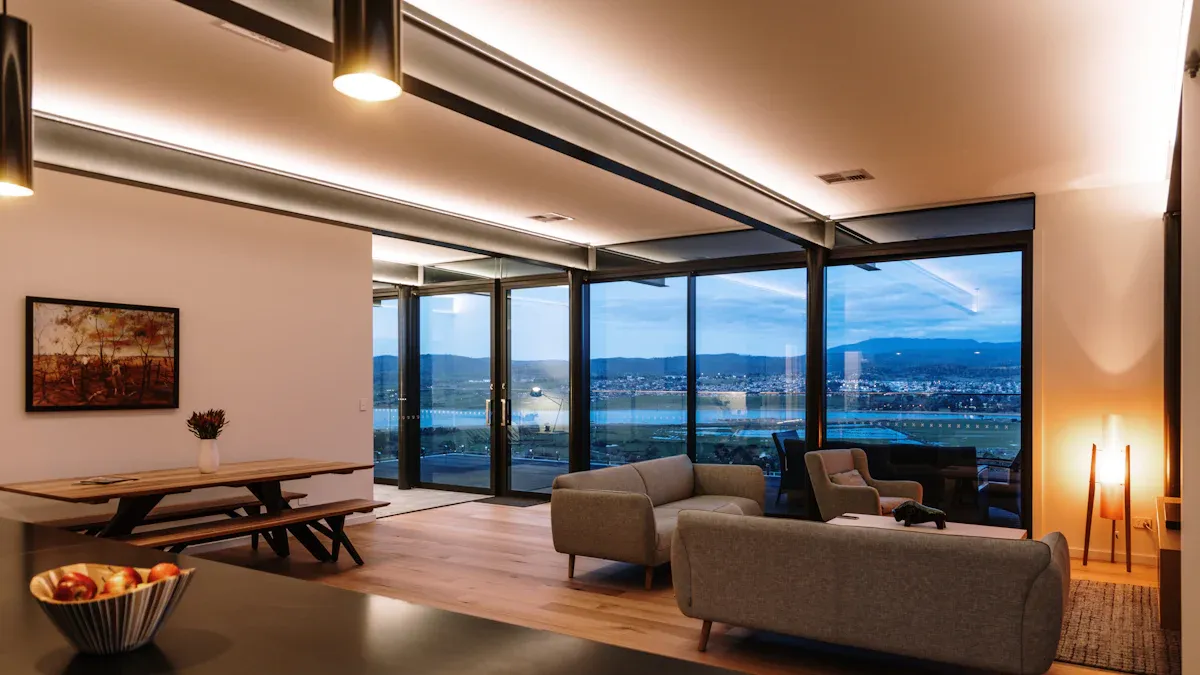
Energy Savings
You probably want to save money on your electricity bill. LED track lights make that easy. These bulbs use much less power than halogen or incandescent lights. Take a look at this table:
Light Type | Power Consumption (W) | Annual Usage (kWh) |
|---|---|---|
Halogen (50W) | 50 | 73 |
LED (10W) | 10 | 14.6 |
If you switch to LED, you can cut your lighting costs by up to 90%. For example, three incandescent bulbs running 10 hours a day cost about $2.16 per month. The same setup with LED bulbs costs only $0.33 per month. That’s a big difference! You also help the planet by reducing carbon emissions and toxic waste. LED track lamps use only 40% to 60% of the power of halogen lights but give you the same brightness.
Tip: Facilities like the Queens Museum saw a 90% drop in energy costs after switching to LED track lighting.
Longevity
You don’t want to keep changing bulbs, right? LED track light bulbs last much longer than other types. Most LED bulbs run for 15,000 to 25,000 hours or more. Incandescent and halogen bulbs usually last just a few thousand hours. An LED bulb can last 3 to 5 times longer than a CFL and up to 30 times longer than an incandescent bulb. That means fewer trips to the store and less hassle for you.
LED bulbs: 15,000–25,000 hours
Halogen bulbs: 1,250–2,250 hours
Incandescent bulbs: 1,000–2,000 hours
Light Quality
You want your space to look great. LED track lights offer excellent color and brightness. High-quality LEDs have a color rendering index (CRI) between 70 and 99, so colors look natural and vibrant. Incandescent and halogen bulbs score 100, but they get hot and burn out fast. LEDs stay cool and last longer. Here’s a quick comparison:
Light Source | CRI Value | Color Rendering Quality | Additional Notes |
|---|---|---|---|
Incandescent | 100 | Excellent | High heat output, shorter lifespan |
Halogen | 100 | Excellent | High heat output, shorter lifespan |
LED (High CRI) | 70-99 | Good to Excellent | Lower heat output, longer lifespan |
LED (Low CRI) | <70 | Poor | Less accurate color rendering capabilities |
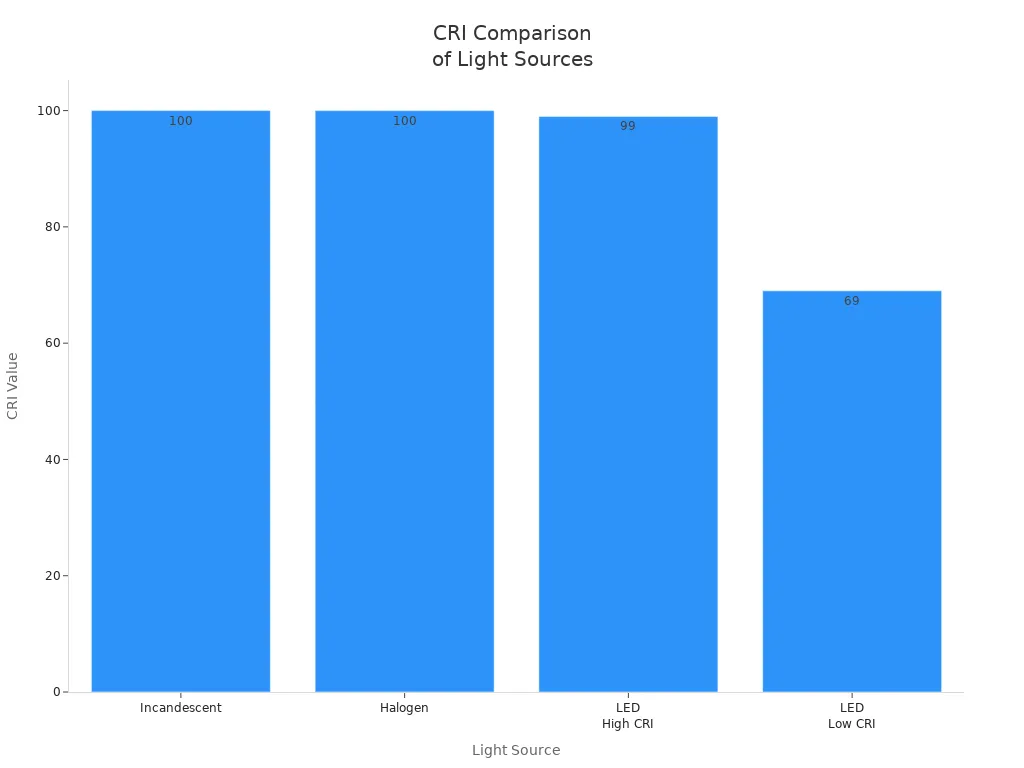
When you choose Track Lighting LED Conversion, you get better light, save money, and enjoy bulbs that last for years.
Track System Types
When you start your Track Lighting LED Conversion, you need to know what kind of track system you have. Not all tracks work the same way. Some tracks use magnets, while others use different shapes and connectors. Here’s a quick look at the most common types:
Track Type | Description |
|---|---|
Magnetic Track | Features embedded magnets for easy light attachment without hooks. |
H-style | Popular for DIY, allows for easy installation and expansion. |
J-style | Most common type, flexible configurations for light fixtures. |
L-style | Simple track design, ideal for displaying artwork. |
Track Head Compatibility
You want your new LED bulbs to fit and work perfectly. To do that, you need to check a few things:
Make sure your track type matches the fixtures you plan to use.
Look at the design of your track heads. Some fixtures only work with certain tracks.
Check the electrical setup. Your system should match the requirements of the LED bulbs.
Find out if your track is line or low voltage, single or two circuits, flexible or straight.
Read the manufacturer’s specs for adapter standards and voltage.
Tip: If you’re not sure about your track type, look for labels or model numbers on the track or fixtures. You can also take a photo and compare it to online guides.
Voltage and Transformers
Voltage matters a lot when you switch to LED track lights. Most homes use line voltage, but some systems run on low voltage. Here’s a table to help you figure out what you have:
Voltage Type | Voltage Range | Notes |
|---|---|---|
Line Voltage | 110-120 volts | Standard voltage for most residential track lighting systems. |
Low Voltage | 12-24 volts | Requires a transformer to step down from standard home voltage. |
Low-voltage systems need a transformer. This device lowers the power from your home’s supply to a safe level for the lights. Sometimes, each track head has its own built-in transformer. Mixing voltage types can damage your lights, so always check compatibility between your track and power supply.
Note: If your system uses low voltage, make sure the transformer supports LED bulbs. Some older transformers only work with halogen or incandescent bulbs.
Now you know how to spot your track type and check voltage. This helps you avoid problems like flickering or bulbs that don’t fit. You’re ready for the next step in your Track Lighting LED Conversion!
Choosing LED Bulbs
Base Types
When you pick LED bulbs for your track lighting, you need to match the base type. The base is the part that connects the bulb to the fixture. If you choose the wrong base, your bulb will not fit or work. Here are the most common base types you will see:
Base Type | Description |
|---|---|
GU10 | Twist-lock base, great for spotlights and directional lighting. You often find these in retail spaces and display cases. |
G13 | Used for linear fluorescent lamps. These work well in commercial settings and some track lighting systems. |
You can check your old bulb or fixture for a label. If you see GU10 or G13, you know what to buy.
Tip: GU10 bulbs twist and lock into place, while G13 bulbs slide into long fixtures.
Wattage & Brightness
You want bright light but also want to save energy. LED track lights use much less wattage than old incandescent bulbs. That means you get the same brightness for less power. Here’s what you should know:
LED track lights use less wattage, so you save money.
Higher wattage gives you more light and a wider beam.
Some LED track lights can produce up to 4,000 lumens. That is enough for both homes and businesses.
If you want a cozy reading nook, pick a bulb with lower lumens. If you need to light up a kitchen or workspace, go for higher lumens.
Note: Always check the packaging for wattage and lumens. More lumens mean a brighter room.
Color Temperature
Color temperature changes how your room feels. LED track lighting comes in many color temperatures. Warm light (2700K–3000K) gives your space a soft, yellow glow. This makes living rooms and bedrooms feel cozy and welcoming. Warm light looks like old incandescent bulbs and helps you relax. It also makes wood and warm colors look richer.
If you want a modern, crisp look, choose cooler color temperatures. These work well in kitchens, offices, and studios.
Tip: For a relaxing vibe, stick with warm light. For a bright, energetic space, try cool white.
Choosing the right LED bulb is a big part of Track Lighting LED Conversion. You get better light, save energy, and make your space look just the way you want.
Track Lighting LED Conversion Guide
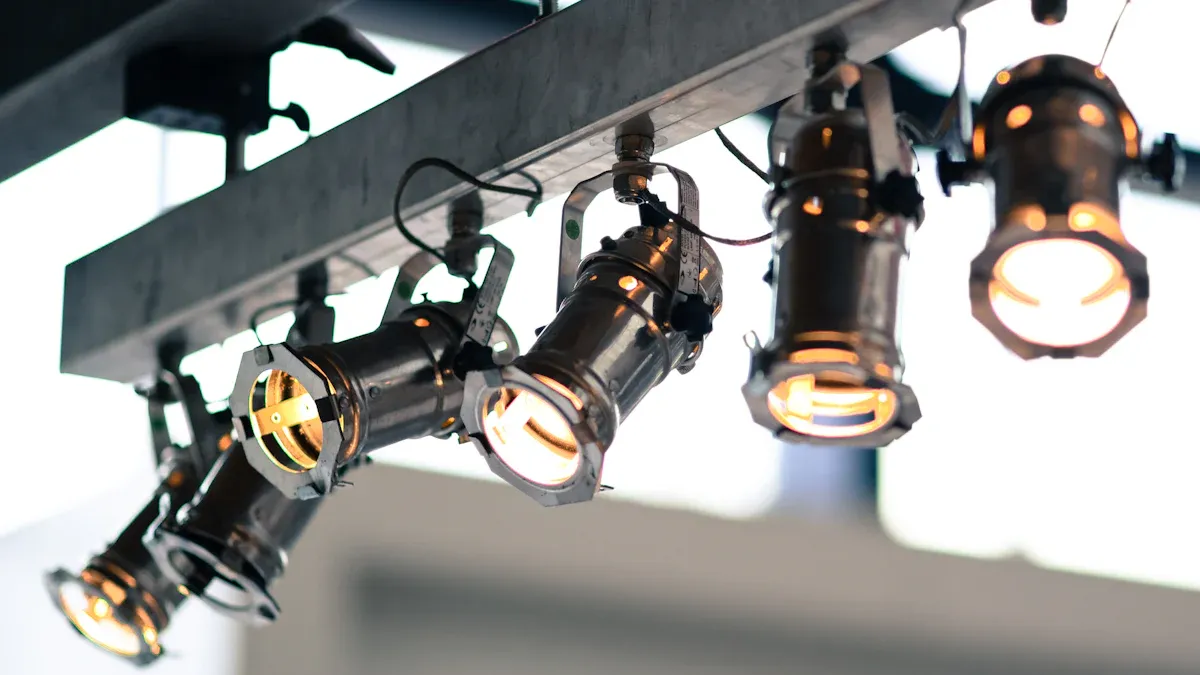
Ready to tackle your Track Lighting LED Conversion? Let’s walk through each step together. You’ll find this process easier than you think, especially if you follow these clear instructions.
Safety Steps
Safety comes first every time you work with electricity. Here’s what you need to do before you start:
Turn off the power at the breaker box. This keeps you safe from electric shocks.
Use a voltage tester to check that all wires are not live. You want to be sure there’s no electricity running through them.
Make sure the junction box is secure. Tighten all connections and check that wires are insulated. This helps prevent hazards later.
Tip: Never rush through safety checks. Take your time and double-check everything before you move on.
Removing Old Bulbs
You need to remove the old bulbs and fixtures before you can install new LEDs. Here’s how you do it:
Twist each bulb counterclockwise to remove it from the track head.
Detach the light fixtures. Some use clips, while others have magnetic connectors. Gently pull them off.
Unscrew the track from the ceiling or wall if you plan to replace the whole system.
Disconnect the wiring that powers the track lighting heads. Make sure the power is off.
Remove the mounting bracket if your system has one.
Look for any damage in the area. Fix anything you find before installing new lights.
Clean up your workspace. Dispose of old bulbs and materials properly.
Note: Handle old bulbs with care. Some may break easily, and you don’t want to deal with glass shards.
Installing LEDs
Now you’re ready to install your new LED track lights. Follow these steps for a smooth setup:
Gather your tools: drill, screws, level, measuring tape, wire strippers, and voltage tester.
Double-check that the power supply is off.
Unpack your LED track lights. Make sure you have all the parts.
Read the product manual. Look for any special instructions or specs.
Plan where you want the track to go. Think about how you want the light to shine in your room.
Use a measuring tape and level to mark the spot for the track.
Drill holes and secure the track with screws.
Connect the wires to the electrical box. Follow the diagram in your manual.
Attach the LED fixtures. Many use magnetic mechanisms, so they snap into place easily.
Check that all connections are tight and secure.
Callout: If your old system used halogen bulbs and a transformer, make sure your new LEDs are compatible with the transformer. Some older transformers don’t work with LED bulbs. You may need to upgrade the transformer for your Track Lighting LED Conversion.
Testing & Troubleshooting
You want your new lights to work perfectly. Here’s how you test and fix common problems:
Plug another device into the same outlet to check the power source.
Look at the track connection. If it’s loose or dirty, clean and tighten it.
Replace any LED bulbs that don’t light up. Make sure they’re compatible with your system.
Tighten any loose wires in the fixture or track.
Make sure there’s enough ventilation around the lights. This helps prevent overheating.
Tip: If your lights flicker or don’t turn on, check the voltage and compatibility again. Sometimes a simple adjustment solves the problem.
You’ve just completed your Track Lighting LED Conversion! You’ve made your space brighter, safer, and more energy-efficient. Enjoy your new lighting setup and the savings that come with it.
Common Issues
Flickering
You might notice your new LED track lights flicker sometimes. This can be annoying, but you can fix it. Flickering usually happens for a few simple reasons:
Loose connections: If the track heads don’t snap in tightly, the bulbs may lose contact and start flickering. Make sure each head is secure.
Voltage fluctuations: Sometimes, your home’s electrical supply changes. This can cause your lights to flicker. If you see this often, you may want to ask an electrician for help.
Tip: Always double-check that every bulb and fixture is firmly attached. A quick twist or push can solve most flickering problems.
Dimming Problems
LED track lights sometimes act strange when you try to dim them. You might see lights that cut out, flash, or don’t respond the way you expect. Here are some common dimming issues:
Drop out: The light shuts off suddenly when you dim it down.
Pop on: The bulb jumps to a bright level when you turn it up.
Dead travel: The dimmer doesn’t change the brightness in some spots.
Ghosting: The bulb glows faintly even when it’s supposed to be off.
Flickering: The light pulses quickly when you use the dimmer.
Strobing: The bulb flashes slowly, almost like a strobe light.
Flashing: The light turns on and off randomly with the dimmer.
You can fix most dimming problems if you:
Use LED bulbs that say “dimmable” on the box.
Check that your dimmer switch works with LED bulbs.
Choose LED products that have good reviews and testing.
Try out your setup before you install everything.
Note: Not all dimmers work with LEDs. If you keep having trouble, you may need to upgrade your dimmer switch.
Fit Issues
Sometimes, LED bulbs or fixtures don’t fit your track system. You can run into problems with size, shape, or wiring. Here’s a quick guide to common fit issues and how to solve them:
Fit Issue | Solution |
|---|---|
Compatibility of track types | Identify your system type (H, J, or L) to make sure parts match. |
Replacing old track | Swap out the whole track and heads for a perfect fit. |
Hidden ceiling surprises | Use spackle and paint to fix small holes or marks left behind. |
Electrical box problems | Make sure the box is secure and centered. Use extra support for heavy lights. |
Old, brittle wiring | Handle wires gently so you don’t damage the insulation. |
Callout: If you’re not sure about your track type, take a photo and compare it to online guides. This helps you pick the right parts and avoid fit issues.
Cost & Savings
Upfront Costs
When you start your track lighting LED conversion, you might notice that LED bulbs and fixtures cost more than traditional options. You pay a bit more at the beginning, but don’t let that scare you off. Here’s a quick look at how the costs compare:
Lighting Type | Upfront Cost |
|---|---|
LED Track Lighting | Higher |
Traditional Lighting | Lower |
LED lights require a higher initial investment compared to traditional lights.
Despite the higher upfront cost, LED lights lead to significant savings over time due to lower energy consumption.
You might wonder why LEDs cost more. Manufacturers use advanced technology to make them last longer and use less power. You pay more now, but you won’t need to buy new bulbs as often. That means fewer trips to the store and less hassle for you.
Tip: If you’re updating a whole room or business, the upfront cost can add up. Try swapping bulbs in stages to spread out your spending.
Long-Term Savings
LED track lighting helps you save money in the long run. You use less electricity, and your bulbs last much longer. Take a look at how the numbers stack up:
Bulb Type | Average Price | Annual Energy Cost (5 hrs/day) | Lifespan |
|---|---|---|---|
Incandescent (60W) | $1.25 | $17.00 | ~1,000 hrs |
CFL (60W equiv.) | $2.40 | $4.25 | ~10,000 hrs |
LED (60W equiv.) | $2.50 | $1.70 | ~25,000–50,000 hrs |
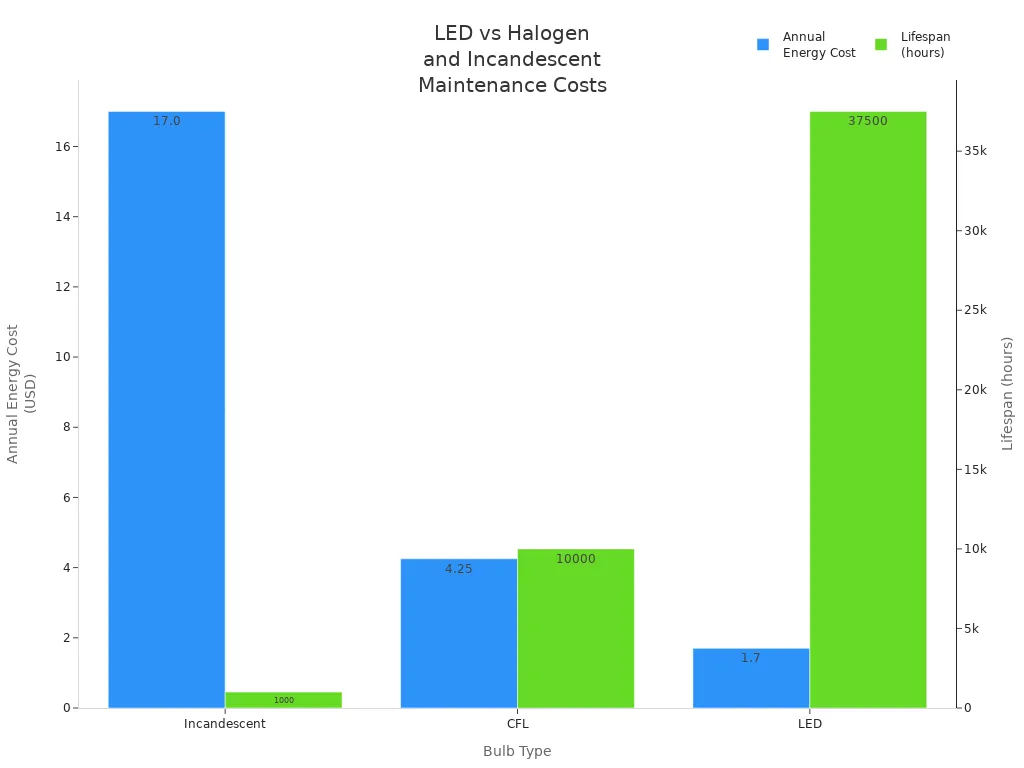
You use about 75% less energy with LEDs than with old bulbs. LEDs last 25 times longer, so you don’t have to replace them as often. They also produce almost no heat, which means your air conditioning works less in the summer. Even small drops in heat can help lower your cooling bills.
The average LED bulb can last 10–15 years with regular use. In homes and businesses, that means big savings in energy and maintenance. You spend less money and time changing bulbs, and you help the planet by creating less waste.
Callout: Switching to LED track lighting is a smart move. You pay a little more upfront, but you save a lot over the years.
Switching your track lighting to LED is simple and smart. You just need to check your system’s voltage, match the right bulbs, and follow safety steps. When you upgrade, you get:
Brighter, adjustable light for any space
Lower energy bills and less waste
Bulbs that last years, not months
Custom styles and colors for your room
Always double-check compatibility and wiring before you start. You’ll enjoy better lighting and save money for years to come!
FAQ
Can I use any LED bulb in my track lighting?
You need to match the bulb base and check the voltage. Not all LED bulbs fit every track system. Look at your old bulb’s label or fixture specs before you buy.
Why do my new LED track lights flicker?
Loose connections or incompatible transformers often cause flickering. Make sure your bulbs snap in tightly. If you still see flickering, check your transformer or ask an electrician for help.
Do LED track lights work with dimmer switches?
Some LED bulbs work with dimmers, but not all. Always choose bulbs labeled “dimmable.” You may need to upgrade your dimmer switch for smooth performance.
How do I know if my track system is compatible with LEDs?
Tip: Check your track type (H, J, or L) and voltage. Read the manufacturer’s guide or compare your track to online photos. If you’re unsure, take a picture and ask a lighting expert.
Will switching to LED track lighting save me money?
Lighting Type | Energy Use | Lifespan | Savings Over Time |
|---|---|---|---|
LED | Low | Long | High |
Halogen | High | Short | Low |
You spend less on energy and replacements with LEDs. Your savings grow every year.
See Also
Transforming High Bay Lights to Energy-Saving LED Options
Comprehensive Guide to Track LED Lighting Systems and Design
Exploring Energy-Saving LED Solutions for Commercial Track Lighting
Complete Guide to Switching Fluorescent Tubes to LED Lighting

